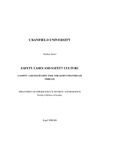JavaScript is disabled for your browser. Some features of this site may not work without it.
| dc.contributor.advisor | Edwards, M. R. | |
| dc.contributor.author | Harries, R. | |
| dc.date.accessioned | 2010-10-12T14:02:49Z | |
| dc.date.available | 2010-10-12T14:02:49Z | |
| dc.date.issued | 2010-10-12 | |
| dc.identifier.uri | http://dspace.lib.cranfield.ac.uk/handle/1826/4606 | |
| dc.description.sponsorship | The intention of this thesis is to define a guideline for the creation of a safety case for use in the field of civil light UAVs. It provides stakeholders with an opportunity to understand how the UAV, as a complete system, has been designed, assembled and will be operated in a safe and competent manner. Not only can it be used to create a safety argument to prove an extant system's integrity, it can be used to identify weaknesses within a new system to allow further energy to be focussed upon the delinquent areas. The need for this approach is linked heavily to the UK's civil UAV market and the vast growth which is forecasted to occur within it over the next two decades. The requirement is also driven by the extant minimal level of regulatory guidance available from within the UK's CAA. The final guideline also applies a more qualitative approach to safety and encompasses those elements of a system which have been predominantly excluded from the majority of safety arguments. By combining a traditional 'hard' safety engineering approach, with a more qualitative and 'people' focussed approach, an enhanced safety argument is created which applies the fundamentals of today's Systems Engineering regime. It should be noted that this revised approach to assembling a safety case for light UAVs does not tackle the most demanding of current UAV challenges which is that of 'sense and avoid'. The aim of this revised form of safety case is to facilitate a more complete body of evidence so that safety engineers, safety managers (or regulators) may make a more accurate, relevant, and consolidated safety assessment of the system under scrutiny. Any decisions at national, or international level, which relates to the 'sense and avoid' issue, may be decomposed and included in further iterations of this guideline. | en_UK |
| dc.language.iso | en | en_UK |
| dc.rights | ©Cranfield Copyright 2009 | en_UK |
| dc.title | Safety cases and safety: safety case elicitation tool for light unmanned air vehicles | en_UK |
| dc.type | Thesis or dissertation | en_UK |
| dc.type.qualificationlevel | Doctoral | en_UK |
| dc.type.qualificationname | EngD | en_UK |
